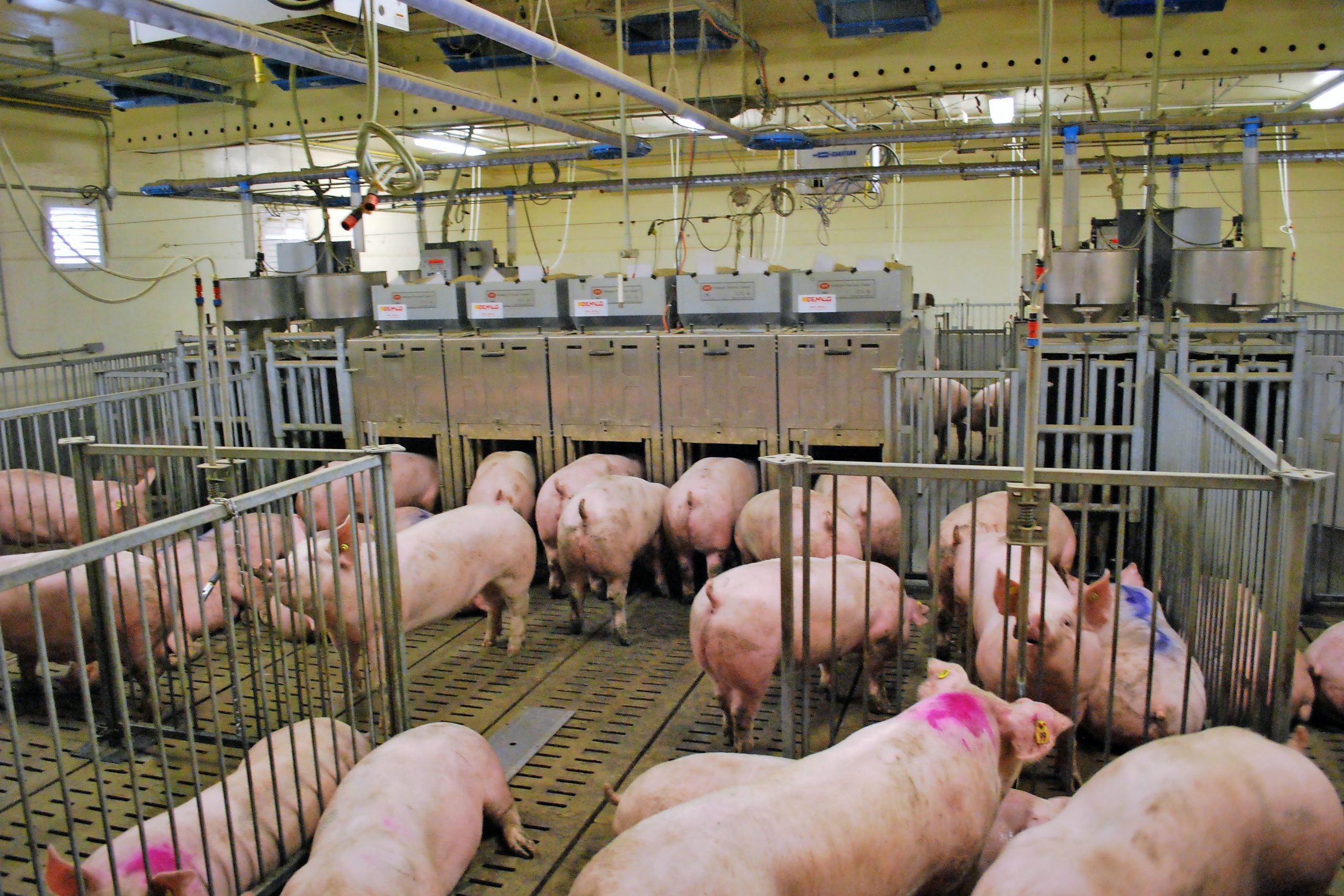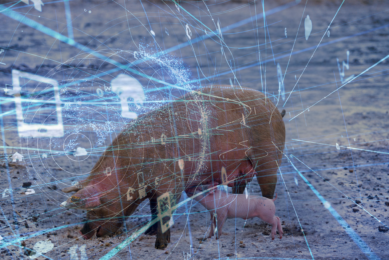Low-cost diets with low excretion levels – it is possible

Formulating pig diets is always a compromise. Do pig producers for example choose minimal feed costs or a diet aimed at achieving low excretion levels? Recent research points out that perhaps they needn’t choose at all…
Currently feed represents more than 70% of the production cost in the growing-finishing pig industry. Most commonly in Canada, pigs are fed accordingly to a three-phase feeding system with fixed energy density (3PF-FE). In this system, the growth period is split into three phases and in each phase, a complete feed is used which has a fixed energy density, being 10.36 MJ/kg.
Not only the nutritional value of feed is important, so is its environmental impact. This is frequently cited because of the pollution caused by the manure spreading. Quantities of phosphorus (P) and nitrogen (N) excreted using that traditional three-phase feeding system are 1.2 kg/pig and 3.4 kg/pig respectively.
With both the nutritional as well as the environmental values in the back of their minds, a research team* consisting of French and Canadian scientists, started out designing new types of pig diets. As a reference, results were always compared to the traditional three-phase feeding system with fixed energy density which had a feed cost of CAN$ 100.33/pig (US$ 73.45) at the time of the trial.
Minimising feed costs and excretion
For several years now, mathematics is used to model the feeding formulation and optimisation methods are used in order to minimise the feed cost and/or phosphorus and nitrogen excretions.
The first studies done in this field were realised at the end of the 1990s and consisted in finding a new way to model pig diets, solving mathematical problems and evaluating the economic impact of this new formulation method. As a result of these studies it was shown that an increase in the number of phases produces a decrease in feed cost.
As an extreme example it is possible to show that moving from the three-phase feeding system to an ideal method at fixed energy density (IF-FE) which is a feeding system considering one phase per day with fixed energy, can reduce feed cost by 3.33%.
However, this feeding system is impracticable for a grower due to the high number of feeds to store. From a mathematical point of view, the models presented in these studies are linear and can be solved easily thanks to existing algorithms and solvers.
Reducing phosphorus and nitrogen
A few years later, studies at the university were done in order to find minimal feed costs while reducing phosphorus and nitrogen excretions. This study did not consider a traditional three-phase feeding system, but rather a feeding system in two phases, such as is more commonly used by European pig producers.
The study showed that feed costs increase when phosphorus and nitrogen excretions are reduced. However, excretions can be considerably reduced with a relatively small feed cost increase. From a mathematical point of view, the problem was modelled as a multi-objective problem. Moreover, the model is still linear and thus easy to solve.
Developing a new feeding system
Since 2011, researchers at the University of Sherbrooke have worked on the development of a new feeding system.
Firstly, they introduced the concept of variable energy density which consists of freeing the energy density of a diet. For example, for a three-phase feeding system with variable energy, the growth period was split into three phases and the complete feed was determined so that it would minimise costs for each phase. Feeds used in each phase can have a different energy density which is unknown prior to the optimisation. As a consequence, feed costs can be reduced by 2.37%. The study showed, however, different results on excretions with a reduction of nitrogen excreted of 5.78% and an increase of phosphorus excreted by 4.9%.
The ideal feeding system with variable energy (IF-VE), which consists of feeding pigs with the optimal cost diet on each day without knowing the energy density of the feed before the optimisation, has a feed cost of CAN$ 94.84 (US$ 69.43), which is 5.5% less than the traditional three-phase feeding system with fixed energy density. The mathematical model associated with this feeding system is still linear and easy to solve.
Feeding system based on blend of two feeds
Secondly, a feeding system was introduced, based on the blend of two feeds. This feeding system is useful for a precision feeding method, called ‘daily phase feeding’ (DPF). In this feeding system, only two feeds will be used and a blend of them is defined for each day.
This feeding programme was studied for several strategies: the energy density can be either fixed or variable and the feeds can be either known before the optimisation or not. In the case of unknown feeds, they can be not complete for a particular day, however, when they are daily blended, they satisfy the requirements day-to-day. In that case, the mathematical model is bi-linear and much harder to solve than the linear ones.
The case of using fixed energy density and known feeds, one feed corresponding to the optimal diet of the first day and the other feed corresponding to the one of the last day, was studied by in 2014. The model associated with this feeding system is once again linear. The results show that using a DPF system can considerably decrease feed cost.
However, a study made in 2015 shows that relationships exist between each feeding system and their corresponding models are presented in details. It became clear that using a DPF system with variable energy density and unknown variables has the best feed cost. Such a feeding programme reduces feed cost by 4%. Moreover, phosphorus and nitrogen excreted can be reduced by 3.3% and 14.8% respectively.

Adding constraints on excretions
This feed cost reduction encouraged to improve the model by adding constraints on phosphorus and nitrogen excretions. The model was combined with the multi-objective one. Using it, it is possible to determine diets on the basis of feed cost, phosphorus excreted and nitrogen excreted, which would reduce the three of them at the same time.
For example, a feeding system can be determined to have the same feed cost as the one currently used and decrease phosphorus and nitrogen excretions by 11.1% and 22.4% respectively. Another feeding system could be chosen to have a decrease in cost of 2% and reductions of phosphorus and nitrogen excretions by 8.2% and 19% respectively.
New hybrid feeding system
The next step was to introduce a new hybrid feeding system which is a mix between a phase feeding system and the DPF method. The concept is as follows: the growth period is split in X phases (to be determined). For each phase, a DPF system was used with unknown feeds and variable energy, and finally two consecutive phases using a common feed.
For example, when X=3, the growth period is split into three phases, feeds 1 and 2 are used in the first phase, feeds 2 and 3 are used in the second one and feeds 3 and 4 are used in the last one. This feeding system is easy to set up because for each phase, only two feeds are used. Using it for minimising the feed cost, it was possible to reduce it by 5.19% while phosphorus and nitrogen excreted are reduced by 2.2% and 17.8%.
Reducing feed costs and excretions
As for the DPF system, the research team combined it with the multi-objective method and reached the same conclusions. It is feasible to determine a lot of feeding systems that reduce both feed cost and excretions. The first example has the same feed cost as a three-phase feeding system using fixed energy but reduces phosphorus and nitrogen excreted by 18% and 16%. Another one can have the same feed cost as DPF, namely a decrease of 4% and reduces phosphorus and nitrogen excretions by 8% and 17% respectively.
In both cases, solutions obtained are examples of results using multi-objective optimisation techniques. Somebody else may prefer to reduce the excretion of phosphorus considerably while the nitrogen that is excreted is not restricted, or the opposite, or even a compromise for both. It is possible to determine a such feeding system.
References available on request.
* Also collaborating on the research: François Dubeau and Jean-Pierre Dussault, University of Sherbrooke, Canada; Mounir Haddou, INSA Rennes, France and Candido Pomar, Agriculture and Agri-Food Canada.











